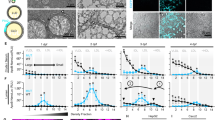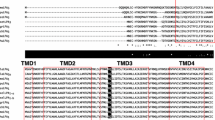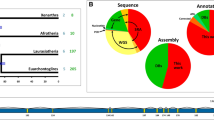Abstract
Endothelial lipase (gene: LIPG; enzyme: EL) is one of three members of the triglyceride lipase family that contributes to lipoprotein degradation within the circulation system and plays a major role in HDL metabolism in the body. In this study, in silico methods were used to predict the amino acid sequences, secondary and tertiary structures, and gene locations for LIPG genes and encoded proteins using data from several vertebrate genome projects. LIPG is located on human chromosome 18 and is distinct from other human ‘neutral lipase’ genes, hepatic lipase (gene: LIPC; enzyme: HL) and lipoprotein lipase (gene: LPL; enzyme: LPL) examined. Vertebrate LIPG genes usually contained 10 coding exons located on the positive strand for most primates, as well as for horse, bovine, opossum, platypus and frog genomes. The rat LIPG gene however contained only 9 coding exons apparently due to the presence of a ‘stop’ codon’ within exon 9. Vertebrate EL protein subunits shared 58–97% sequence identity as compared with 38–45% sequence identities with human HL and LPL. Four previously reported human EL N-glycosylation sites were predominantly conserved among the 10 potential N-glycosylation sites observed for the vertebrate EL sequences examined. Sequence alignments and identities for key EL amino acid residues were observed as well as conservation of predicted secondary and tertiary structures with those previously reported for horse pancreatic lipase (PL) (Bourne et al. 1994). Several potential sites for regulating LIPG gene expression were observed including CpG islands near the LIPG gene promoter and a predicted microRNA binding site near the 3’-untranslated region. Promoter regions containing functional polymorphisms that regulate HDL cholesterol in baboons were conserved among primates but not retained between primates and rodents. Phylogenetic analyses examined the relationships and potential evolutionary origins of the vertebrate LIPG gene subfamily with other neutral triglyceride lipase gene families, LIPC and LPL. It is apparent that the triglyceride lipase ancestral gene for the vertebrate LIPG gene predated the appearance of fish during vertebrate evolution >500 million years ago.






Similar content being viewed by others
References
Ahmed W, Orasanu G, Nehra V, Asatryan L, Rader DJ, Ziouzenkova O, Plutzky J (2006) High-density lipoprotein hydrolysis by endothelial lipase activates PPARalpha: a candidate mechanism for high-density lipoprotein-mediated repression of leukocyte adhesion. Circ Res 98:490–498
Altschul F, Vyas V, Cornfield A, Goodin S, Ravikumar TS, Rubin EH, Gupta E (1990) Basic local alignment search tool. J Mol Biol 215:403–410
Benlian P, De Gennes JL, Foubert L, Zhang H, Gagne SE, Hayden M (1996) Premature atherosclerosis in patients with familial chylomicronemia caused by mutations in the lipoprotein lipase gene. N Engl J Med 335:848–854
Blanchette M, Kent WJ, Riemer C, Elnitski L, Smit AF, Roskin KM, Baertsch R, Rosenbloom K, Clawson H, Green ED (2004) Aligning multiple genomic sequences with the threaded blockset aligner. Genome Res 14:708–715
Bonne ACM, den Bieman MG, van Lith H, van Zutphen BFM (2001) Sequencing and chromosomal assignment of the rat endothelial-derived lipase gene (Lipg). DNA Seq 12:285–287
Bourne Y, Martinez C, Kerfelec B, Lombardo D, Chapus C, Cambillau C (1994) Horse pancreatic lipase. The crystal structure refined at 2.3-A resolution. J Mol Biol 238:709–732
Bovine Genome Project (2008) http://hgsc.bcm.tmc.edu/projects/bovine
Broedl UC, Jin W, Fuki IV, Glick JM, Rader DJ (2004) Structural basis for endothelial lipase tropism for HDL. FASEB J 18:1891–1893
Brown RJ, Rader DJ (2007) Lipases as modulators of atherosclerosis in murine models. Curr Drug Targets 8:1307–1309
Cai SJ, Wong DM, Chen SH, Chan L (1989) Structure of the human hepatic triglyceride lipase gene. Biochemistry 28:8966–8971
Cheng W, Guo L, Zhang Z, Soo HM, Wen C, Wu W, Peng J (2006) HNF factors form a network to regulate liver-enriched genes in zebrafish. Dev Biol 294:482–496
Chimpanzee Sequencing Analysis Consortium (2005) Initial sequence of the chimpanzee genome and comparison with the human genome. Nature 437:69–87
Clark HF, Gurney AL, Abaya E, Baker K, Baldwin D, Brush J, Chen J, Chow B, Chui C, Crowley C, Currell B, Deuel B, Dowd P, Eaton D, Foster J, Grimaldi C, Gu Q, Hass PE, Heldens S, Huang A, Kim HS, Klimowski L, Jin Y, Johnson S, Lee J, Lewis L, Liao D, Mark M, Robbie E, Sanchez C, Schoenfeld J, Seshagiri S, Simmons L, Singh J, Smith V, Stinson J, Vagts A, Vandlen R, Watanabe C, Wieand D, Woods K, Xie MH, Yansura D, Yi S, Yu G, Yuan J, Zhang M, Zhang Z, Goddard A, Wood WI, Godowski P, Gray A (2003) The secreted protein discovery initiative (SPDI), a large-scale effort to identify novel human secreted and transmembrane proteins: a bioinformatics assessment. Genome Res 13:226–2270
Cohen JC (2003) Endothelial lipase: direct evidence for a role in HDL metabolism. J Clin Invest 111:1–3
Consortium MouseGenomeSequencing (2002) Initial sequencing and comparative analysis of the mouse genome. Nature 420:520–562
Cox LA, Birnbaum S, Mahaney MC, Rainwater DL, Williams JT, VandeBerg JL (2007) Identification of promoter variants for baboon endothelial lipase that regulate baboon HDL-cholesterol levels. Circulation 116:1185–1195
Datta S, Luo CC, Li WH, VanTuinen P, Ledbetter DH, Brown MA, Chen SH, Liu S, Chan L (1988) Human hepatic lipase. Cloned cDNA sequence, restriction fragment length polymorphisms, chromosomal localization, and evolutionary relationships with lipoprotein lipase and pancreatic lipase. J Biol Chem 263:1107–1110
deLemos AS, Wolfe ML, Long CJ, Sivapackianathan R, Rader DJ (2002) Identification of genetic variants in endothelial lipase in persons with elevated high-density lipoprotein cholesterol. Circulation 106:1321–1326
Dichek HL, Fojo SS, Beg OU, Skarlatos SI, Brunzell JD, Cutler GB Jr, Brewer HB Jr (1991) Identification of two separate allelic mutations in the lipoprotein lipase gene of a patient with the familial hyperchylomicronemia syndrome. J Biol Chem 266:473–477
Donoghue PCJ, Benton MJ (2007) Rocks and clocks: calibrating the tree of life using fossils and molecules. Trends Genet 22:424–431
Dugi KA, Dichek HL, Santamarina-Fojo S (1995) Human hepatic and lipoprotein lipase: the loop covering the catalytic site mediates lipase substrate specificity. J Biol Chem 270:25396–25401
Edmondson AC, Brown RJ, Kathiresan S, Cupples LA, demissie S, Manning AK, Jensen MK, Rimm EB, Wang J, Rodrigues A, Bamba V, Khetarpal SA, Wolfe ML, Derohannessian S, Li M, Reilly MP, Aberle J, Evans D, Hegele RA, Rader DJ (2009) Loss-of-function variants in endothelial lipase are a cause of elevated HDL cholesterol in humans. J Clin Invest 119:1042–1050
Emmanuelsson O, Brunak S, von Heijne G, Nielson H (2007) Locating proteins in the cell using TargetP, SignalP and related tools. Nat Protocols 2:953–971
Felsenstein J (1985) Confidence limits on phylogenies: an approach using the bootstrap. Evolution 39:783–791
Felsenstein J, Churchill GA (1996) A Hidden Markov Model approach to variation among sites in rate of evolution. Mol Biol Evol 13:93–104
Gasteiger E, Hoogland C, Gattiker A, Duvaud S, Wilkins MR, Appel RD, Bairoch A (2005) Protein identification and analysis tools on the ExPASy server. In: Walker JM (ed) The proteomics protocols handbook. Humana Press, New Jersey, pp 571–607
Griffon N, Jin W, Petty TJ, Millar J, Badellino KO, Saven JG, Marchadier DH, Kempner ES, Billheimer J, Glick JM, Rader DJ (2009) Identification of the active form of endothelial lipase, a homodimer in a head-to-tail conformation. J Biol Chem 284:23322–23330
Guex N, Peitsch MC (1997) SWISS-MODEL and the Swiss-PdbViewer: an environment for comparative protein modelling. Electrophoresis 18:2714–2723
Gupta R, Brunak S (2002) Prediction of glycosylation across the human proteome and the correlation to protein function. Pacific Symp Biocomput 7:310–322
Hall TA (1999) BioEdit: a user-friendly biological sequence alignment editor and analysis program for Windows 95/98/NT. Nucleic Acids Symp Ser 41:95–98
Hill JS, Yang D, Nikazy J, Curtiss LK, Sparrow JT, Wong H (1998) Subdomain chimeras of hepatic lipase and lipoprotein lipase. Localization of heparin and cofactor binding. J Biol Chem 273:30979–30984
Hirata K, Dichek HL, Cioffi JA, Choi SY, Leeper NJ, Quintana L, Kronmal GS, Cooper AD, Quertermous T (1999) Cloning of a unique lipase from endothelial cells extends the lipase gene family. J Biol Chem 274:14170–14175
Horse Genome Project (2008) http://www.uky.edu/Ag/Horsemap/
International Human Genome Sequencing Consortium (2001) Initial sequencing and analysis of the human genome. Nature 409:860–921
Jaye M, Lynch KJ, Krawiec J, Marchadier D, Maugeais C, Doan K, South V, Amin D, Perrone M, Rader DJ (1999) A novel endothelial-derived lipase that modulates HDL metabolism. Nat Genet 21:424–428
Jin W, Sun G-S, Marchadier D, Octtaviani E, Glick JM, Rader DJ (2003) Endothelial cells secrete triglyceride lipase and phospholipase activities in response to cytokines as a result of endothelial lipase. Circ Res 92:644–650
Jin W, Fuki IV, Seidah NG, Benjannet S, Glick JM, Rader DJ (2005) Proprotein convertases are responsible for proteolysis and inactivation of endothelial lipase. J Biol Chem 280:36551–36559
Jin J, Wang X, Millar JS, Quertermous T, Rothblat GH, Glick JM, Rader DJ (2007) Hepatic proprotein convertases modulate HDL metabolism. Cell Metab 6:129–136
Kent WJ, Sugnet CW, Furey TS (2003a) The human genome browser at UCSC. Genome Res 12:994–1006
Kent WJ, Baertsch R, Hinrichs A, Miller W, Haussler D (2003b) Evolution’s cauldron: duplication, deletion, and rearrangement in the mouse and human genomes. Proc Natl Acad Sci USA 100:11484–11489
Kimura M (1983) The neutral theory of molecular evolution. Cambridge University Press, Cambridge
Klein SL, Strausberg RL, Wagner L, Pontius J, Clifton SW, Richardson P (2002) Genetic and genomic tools for Xenopus research: the NIH xenopus initiative. Dev Dyn 225:384–391
Kobayashi J, Applebaum-Bowden D, Dugi KA, Brown DR, Kashyap VS, Parrott C, Duarte C, Maeda N, Santamarina-Fojo S (1996) Analysis of protein structure-function in vivo. Adenovirus-mediated transfer of lipase lid mutants in hepatic lipase-deficient mice. J Biol Chem 271:26296–262301
Kojima Y, Hirata K, Ishida T, Shimokawa Y, Inoue N, Kawashima S, Quertermous T, Yokoyama M (2004) Endothelial lipase modulates monocyte adhesion to the vessel wall. A potential role in inflammation. J Biol Chem 279:54032–54038
Kopp J, Schwede T (2004) The SWISS-MODEL Repository of annotated three-dimensional protein structure homology models. Nucleic Acids Res 32:D230–D234
Lindegaard MLS, Olivcrona G, Christofferson C, Kratky D, Hannibal J, Petersen BL, Zechner R, Damm P, Nielson LB (2005) Endothelial and lipoprotein lipases in human and mouse placenta. J Lipid Res 46:2339–2346
Ma K, Cilingiroglu M, Otvos JD, Ballantyne CM, Marian AJ, Chan L (2003) Endothelial lipase is a major genetic determinant for high-density lipoprotein concentration, structure and metabolism. Proc Natl Acad Sci USA 100:2748–2753
Martin GA, Busch SJ, Meredith GD, Cardin AD, Blankenship DT, Mao SJT, Rechtin AE, Woods CW, Racke MM, Schafer MP, Fitzgerald MC, Burke DM, Flanagan MA, Jackson RL (1988) Isolation and cDNA sequence of human postheparin plasma hepatic triglyceride lipase. J Biol Chem 263:10907–10914
McGuffin LJ, Bryson K, Jones DT (2000) The PSIPRED protein structure prediction server. Bioinformatics 16:404–405
Mikkelsen TS, Wakefield MJ, Aken B, Amemiya CT, Chang JL, Duke S, Garber M, Gentles AJ, Goodstadt L, Heger A, Jurka J, Kamal M, Mauceli E, Searle SMJ, Sharpe T, Baker MJ, Batzer MA, Benos PV, Belov K, Clamp M, Cook A, Cuff J, Das R, Davidow L, Deakin JE, Fazzari MJ, Glass JL, Grabherr M, Greally JM, Gu W, Hore TA, Huttley GA, Kleber M, Jirtle RL, Koina E, Lee JT, Mahony S, Marra MA, Miller RD, Nicholls RD, Oda M, Papenfuss AT, Parra ZE, Pollock DD, Ray DA, Schein JE, Speed TP, Thompson K, VandeBerg JL, Wade CM, Walker JA, Waters PD, Webber C, Weidman JR, Xie X, Zody MC, Broad Institute Genome Sequencing Platform, Broad Institute Whole Genome Assembly Team, Marshall Graves JA, Ponting CP, Breen M, Samollow PB, Lander ES, Lindblad-Toh K (2007) Genome of the marsupial Monodelphis domestica reveals innovation in non-coding sequences. Nature 447:167–177
Miller GC, Long CJ, Bojilova ED, Marchadier D, Badellino KO, Blanchard N, Fuki IV, Glick JM, Rader DJ (2004) Role of N-linked glycosylation in the secretion and activity of endothelial lipase. J Lipid Res 45:2080–2087
Myatt SS, Eric W-F, Lam EW-F (2007) The emerging roles of forkhead box (Fox) proteins in cancer. Nature Revs Cancer 7:847–859
Otera H, Ishida T, Nishiuma T, Kobayashi K, Kotani Y, Yasuda T, Kundu RK, Quertermous T, Hirata K, Nishimura Y (2009) Targeted inactivation of endothelial lipase attenuates lung allergic inflammation through raising plasma HDL levels and inhibiting eosinophil infiltration. Am J Physiol Lung Cell Mol Physiol 296:L594–L602
Pistillo D, Manzi A, Tino A, Boyl PP, Graziani F, Malva C (1998) The Drosophila melanogaster lipase homologs: a gene family with tissue and developmental specific expression. J Mol Biol 276:877–885
Rat Genome Sequencing Project Consortium (2004) Genome sequence of the Brown Norway rat yields insights into mammalian evolution. Nature 428:493–521
Saitou N, Nei M (1987) The neighbour-joining method: a new method for reconstructing phylogenetic trees. Mol Biol Evol 4:406–425
Saxonov S, Berg P, Brutlag DL (2006) A genome-wide analysis of CpG dinucleotides in the human genome distinguishes two distinct classes of promoters. Proc Natl Acad Sci USA 103:1412–1417
Sendak RA, Bensadoun A (1998) Identification of a heparin-binding domain in the distal carboxyl-terminal region of lipoprotein lipase by site-directed mutagenesis. J Lipid Res 39:1310–1315
Shimokawa Y, Hirata K, Ishida T, Kojima Y, Inoue N, Quertermous T, Yokoyama M (2005) Increased expression of endothelial lipase in rat models of hypertension. Cardiovasc Res 66:594–600
Siepel A, Haussler D (2005) Phylogenetic hidden markov models. In: Nielsen R (ed) Statistical methods in molecular evolution. Springer, New York, pp 325–351
Siepel A, Bejerano G, Pedersen JS, Hinrichs AS, Hou M, Rosenbloom K, Clawson H, Spieth J, Hillier LW, Richards S (2005) Evolutionarily conserved elements in vertebrate, insect, worm, and yeast genomes. Genome Res 8:1034–1050
Skropeta D, Settasatian C, McMahon MR, Shearston K, Caiazza D, McGrath KC, Jin W, Rader DJ, Barter PJ, Rye KA (2007) N-Glycosylation regulates endothelial lipase-mediated phospholipid hydrolysis in apoE- and apoA-I-containing high density lipoproteins. J Lipid Res 48:2047–2057
Stefani G, Slack FJ (2008) Small non-coding RNAs in animal development. Nat Rev Mol Cell Biol 9:219–230
The MGC Program Team (2002) Generation and initial analysis of more than 15, 000 full-length human and mouse cDNA sequences. Proc Natl Acad Sci USA 99:16899–16903
The MGC Project Team (2004) The status, quality, and expansion of the NIH full-length cDNA project: the Mammalian Gene Collection (MGC). Genome Res 14:2121–2127
Thierry-Mieg D, Thierry-Mieg J (2006) AceView: a comprehensive cDNA-supported gene and transcripts annotation. Genome Biology 7, S12 http://www.ncbi.nlm.nih.gov/IEB/Research/Acembly/index.html?human
Van De Peer Y, de Wachter R (1994) TreeCon for Windows: a software package for the construction and drawing of evolutionary trees for the Microsoft Windows environment. Comput Appl Sci 10:569–570
Walker JR, Davis T, Seitova A, Butler-Cole C, Weigelt J, Sundstrom M, Arrowsmith CH, Edwards AM, Bochkarev A, Dhe-Paganon S (2010) Protein data bank entry for human pancreatic lipase-related protein 1 (2PPL) http://www.rcsb.org/pdb/explore/explore.do?structureId=2PPL
Warren WC, Hillier LW, Marshall Graves JA, Birney E, Ponting CP, Grützner F, Belov K (2008) Genome analysis of the platypus reveals unique signatures of evolution. Nature 453:175–183
Winkler FK, D’Arcy A, Hunziker W (1990) Structure of human pancreatic lipase. Nature 343:771–774
Wion KL, Kirchgessner TG, Lusis AJ, Schotz MC, Lawn RM (1987) Human lipoprotein lipase complementary DNA sequence. Science 235:1638–1641
Wong H, Davis RC, Nikazy J, Seebart KE, Schotz MC (1991) Domain exchange: characterization of a chimeric lipase of hepatic lipase and lipoprotein lipase. Proc Natl Acad Sci USA 88:11290–11294
Yang Z (1995) A space-time process model for the evolution of DNA sequences. Genetics 139:993–1005
Yasuda T, Hirata K, Ishida T, Kojima Y, Tanaka H, Okada T, Quertermous T, Yokoyama M (2007) Endothelial lipase is increased by inflammation and promotes LDL uptake in macrophages. J Atheroscler Thromb 14:192–201
Acknowledgments
This project was supported by NIH Grants P01 HL028972 and P51 RR013986. In addition, this investigation was conducted in facilities constructed with support from Research Facilities Improvement Program Grant Numbers 1 C06 RR13556, 1 C06 RR15456, 1 C06 RR017515.
Author information
Authors and Affiliations
Corresponding author
Electronic supplementary material
Below is the link to the electronic supplementary material.
Supplementary Table 1
Vertebrate lipoprotein lipase (LPL andLPL), hepatic lipase (HL andLIPC), pancreatic lipase (PL andLIPP), pancreatic lipase related protein 1 (LPR1 andLIPR1) and hormone-sensitive lipase (LPS andLIPS) proteins and genes. RefSeq: the reference amino acid sequence; 1predicted Ensembl amino acid sequence; 2not available; 3Contig refers to a DNA scaffold for sequencing analyses; 4refers to an incomplete sequence; GenBank IDs are derived from NCBI sources http://www.ncbi.nlm.nih.gov/genbank/; Ensembl ID was derived from Ensembl genome database http://www.ensembl.org; UNIPROT refers to UniprotKB/Swiss-Prot IDs for individual acid lipases (see http://kr.expasy.org); bps refers to base pairs of nucleotide sequences; pI refers to theoretical isoelectric points; the number of coding exons are listed. (XLS 37 kb)
Supplementary Table 2
Summary ofLIPGpromoter alignments for human, mouse, rat and opossum genomes. Unlike many conservation-scoring programs, note that phastCons does not rely on a sliding window of fixed size; therefore, short highly-conserved regions and long moderately conserved regions can both obtain high scores. More information about phastCons can be found in Siepel et al. (2005). The LIPG promoter positions are described in Table 2: human, mouse and rat on chromosome 18; opossum on chromosome 3. (XLS 80 kb)
Rights and permissions
About this article
Cite this article
Holmes, R.S., VandeBerg, J.L. & Cox, L.A. Vertebrate endothelial lipase: comparative studies of an ancient gene and protein in vertebrate evolution. Genetica 139, 291–304 (2011). https://doi.org/10.1007/s10709-011-9549-1
Received:
Accepted:
Published:
Issue Date:
DOI: https://doi.org/10.1007/s10709-011-9549-1




